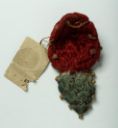Dyeing: Feeling Blue
Step number six. In the third dye, indigo is added to the section that has already been dyed yellow to create a bright shade of green. While the yellow has faded over the years, the green is still a very strong shade because of the indigo dye, which is much more durable.
Creating blue was a perfect science. A traditional Indigovat consisted of indigo, treacle sugar and quicklime. For the dye to be of the best quality, the mixture must be tested to check that it is sufficiently alkaline. Driessen describes how in Semarang, a banana is peeled and then dropped into the dye – if it remains hard, then the mix is neutral or acidic, and so needs more lime. If the fruit becomes soft, the mix is ready for dyeing.
Javanese philosophy was also a part of this science. There was a belief that if a couple argued while mixing the blue, the material would not dye. So widows or unmarried women took up the work, making an exact and peaceful blue. The huge preparation of these dye-baths were important to the ritual. Indigo was sometimes “fed” for weeks with other materials belonging to secret recipes, passed down through generations…


](https://micrio.thingsthattalk.net/LtxqD/views/max/251x128.s.jpg)